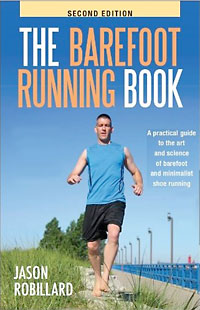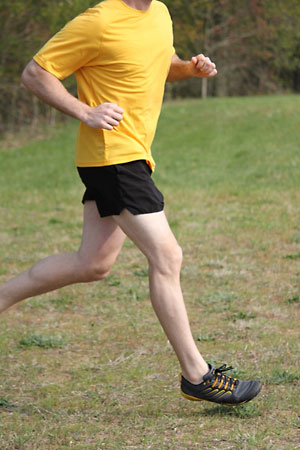
Merrell "Barefoot Expert" Jason Robillard running in the minimalist Trail Gloves. (Image courtesy of Merrell)
While barefoot running may be the hottest trend on the exercise market these days, there has been an avid following of barefoot runners and hikers for years. Whether it's with the interest of injury prevention or simply the freedom of being in nature sans footwear, barefooting buffs are popping up everywhere.
If you're interested in trail running or hiking barefoot or with minimal footwear, consider the information below.
Unsurprisingly, what’s right for one person, isn’t necessarily for another. While some will find barefoot running or hiking to be incredibly satisfying (maybe even life changing), others will insist on slipping their traditional shoes right back on. With a little education, you’ll be able to determine if going barefoot is right for you.
Who Should Go Barefoot
Runners
The recommendations on who should and shouldn’t run barefoot are diverse. As with any training tool, every runner demands different techniques to stay healthy and improve performance.
Jason Robillard, one of Merrell’s “Barefoot Experts” and founder of the educational site Barefoot Running University, says, “going barefoot cured most of the running injuries I experienced in traditional running shoes and helped me get in the training volume I needed for longer races.” The ultra runner first tried running barefoot in 1992, got serious about it by 2005, and now educates both novice and experienced barefoot runners.
Sacramento-based podiatrist Dr. Kevin Kirby, however, calls for moderation amidst the excitement over barefoot running. “It’ll be good for some people and not for others,” says the doctor who has worked with many Western States 100 ultra runners. “You have to take into account body weight, running speed, distance, foot type, injury history, and what type of shoe you’ve used in the past when making your decision.”
Like many barefoot experts and enthusiasts, Kirby emphasizes that a hasty transition into barefoot running will end in injury. “The key is to listen to your body,” he says. While the internet is awash with stories of metatarsal stress fractures resulting from barefoot running, many of these are caused by an overly enthusiastic entrance into the world of barefooting.
Hikers
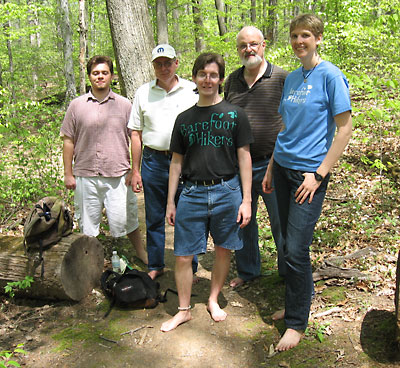
Barefoot hikers Ben, Ken, Barefoot Chris Roat, Scott, and AT barefoot thru-hiker Susan Letcher hike in Pennsylvania's Tyler State Park in 2007. (Image courtesy of Chris Roat and Barefoot Hikers of PA)
Since hiking involves less pounding than running, there are fewer concerns over injuries. “Anyone who is in reasonable physical shape should be able to do it,” says Chris Roat of Barefoot Hikers of PA, who has been going barefoot full-time since 1998.
“I think it is therapeutic in that it provides a more peaceful and connected awareness with nature," says Roat. "It also promotes a more gentle walking gait that may prove beneficial to people who are suffering from impact-related knee, hip, and back pain.”
Jim Guttmann of Barefoot Hikers of Minnesota agrees, recommending barefoot hiking to just about anyone. “Unless you have a specific injury or medical condition that would keep you from doing it, anyone can give it a try,” says Guttmann, who started barefoot hiking in 2000 and was hooked on his first barefoot hike.
"It was so amazing to actually feel the trail below my feet," he says. His Minnesota hiking group attracts both young and old from toddlers up to hikers in their 70s looking for a closer connection with nature.
Check with a medical professional before walking or running barefoot if you have foot issues that affect your gait or sensory loss to your feet.
What to Wear
Runners
The good news for trail runners is that your surface of choice may be ideal for testing your barefoot or minimalist abilities. As a result of the uneven terrain on trails, it is generally recommended to go down in support from a road shoe. This allows the runner to sense and adapt to holes, ruts, and rocks.
Dr. Kirby says he directs trail runners to thinner-soled shoes. “The thinner the sole, the less likely you are to sprain an ankle,” he explains. He cautions, however, that you are also at greater risk to step on a rock and bruise your foot with a less substantial shoe, so it is important to choose softer trails to test and to keep your eyes on the trail ahead.
While many experts recommend a lighter weight shoe for trail running, going completely barefoot or wearing just a minimalist or barefoot model is another category entirely. Be sure to consider the differences between going barefoot or wearing minimalist shoes versus the shoes you’ve been wearing for your entire life.
Robillard opts for going barefoot whenever possible, but wears Merrell’s minimalist shoes when the conditions or race distance warrants it. Living in Michigan, he wears minimalist shoes during the winter, as well as for longer distance races.
Hikers
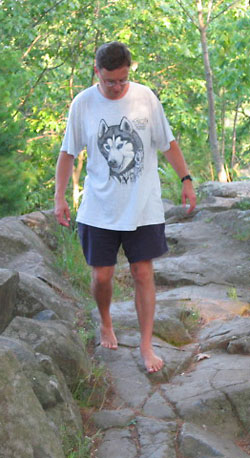
Jim Guttmann navigates a rocky path barefoot at Interstate State Park in Minnesota. (Image courtesy of Rita Guttmann and Barefoot Hikers of Minnesota)
Many barefoot hikers are purists, preferring to go completely barefoot. “While minimal shoes can provide some protection from particularly rough terrain, I think they can also give a false sense of security, perhaps making one more prone to injury,” says Roat.
Indeed, completely barefoot hiking is all about the sensory feedback provided by being barefoot, allowing one to adjust to ruts, roots, and rocks on the trail. "With bare soles, we can also literally feel the world beneath us — cool green grass, a soft carpet of moss, warm squishy mud, the hardness of rocks and roots," he says. "Why wear shoes or boots to unnecessarily isolate ourselves from these sensations?"
Guttmann reports that most of his group is barefoot 100 percent of the time. “We have people that bring along lighter shoes for tough parts of the trails, but given the choice, I’ll go completely barefoot,” he says.
He compares more rigid shoes to wearing boxing gloves on your hands. “They aren’t flexible and you can’t bend your fingers; minimalist footwear, however, is like wearing light gloves, so you can move your fingers without being completely exposed.”
The one time when barefoot hikers are more likely to choose minimalist footwear rather than being barefoot is in extreme weather conditions. If you are out in chilly or hot conditions, minimalist shoes can protect your feet and also allow you to wear socks for further defense.
Where to Go
Runners
“Most of the population is habitually wearing shoes and are not used to their skin hitting the ground. So if they are going to run barefoot, I’d only recommend running on a beach or a grassy field where there are not objects that can hurt your feet,” says Dr. Kirby.
Robillard says he has made barefoot and minimalist running work on even the gnarliest terrain. “Part of it is just technique,” he says, “You get good at seeing the trail in front of you and being able to avoid major debris.”
If there is risk of puncture wounds or injuries, err on the side of safety and wear at least minimalist shoes to protect your feet.
Hikers
Guttmann’s group usually stays away from bushwhacking and hikes on established trails. “Whether it is grass, packed moss, fallen leaves, or forest floor, each type of trail has its own sensation,” he explains. “It adds a whole new dimension to the experience."
Roat’s trail of choice is softly packed dirt or mud, which he says is best for new barefoot hikers. “Grass is also okay, but one needs to be more mindful of possible hidden obstacles,” he warns.
For beginners, rough and rocky terrain should be avoided. Even paved paths can be abrasive for someone who isn’t accustomed to going barefoot. Begin with soft, unobstructed trails in order to gain confidence and awareness before graduating to more difficult terrain.
How to Strike: Heel vs. Forefoot
Runners
Somewhere around 80 percent of runners are heel strikers, but barefoot runners tend to strike on the forefoot or midfoot. It is hypothesized that we tend to heel strike because:
- it requires less lower leg muscle strength, and
- our shoes encourage such form as a result of their highly cushioned heels.
Barefoot heel strike video from Dr. Daniel Lieberman's Skeletal Biology Lab at Harvard.
Many hypothesize that the form and added impact forces associated with heel striking leads to various injuries, though the jury is still out.
Dr. Daniel Lieberman, a Harvard evolutionary biologist, has examined different running styles in his lab. His research, partially funded by Vibram USA, demonstrates that participants who grew up running barefoot usually ran on their forefeet and came down with less force than their shoe-wearing, heel-striking counterparts.
“What we’ve shown is that different ways of hitting the ground have different consequences for collision and mechanics,” explains Dr. Lieberman of his research.
Dr. Lieberman’s research bore this out, showing that a heel striker has a stiffer foot at the moment of landing. With that exaggerated stride and stiff landing, a heel striker tends to collide with the ground in a more pronounced manner. With the leg straight out in front of the body upon landing, effectively putting the brakes on, the entire body feels each strike.
“The main problem with heel striking is overstriding,” explains Washington D.C.-based podiatrist Dr. Stephen Pribut. “You’re reaching out too far with your foot and that can cause all sorts of problems.”
“The issue really comes down to form,” agrees Robillard. “It just happens to be the same form you use when barefoot running.”
Forefoot heel strike video from Dr. Daniel Lieberman's Skeletal Biology Lab at Harvard.
In comparison, forefoot strikers tend to be better aligned, with the feet directly under the body. This means that only the foot’s motion stops at the moment of collision, rather than the entire leg, eliminating that ripple effect up to the knees and hips. The knee and ankle tend to be flexed upon impact as well, increasing compliance of the entire leg.
Some believe that while heel striking may lead to knee, hip, and lower leg injuries, forefoot striking can cause calf and Achilles issues as a result of the increased tension and load. Metatarsal stress fractures are another concern that has arisen since the popularization of barefoot running.
While some of these injuries may be inherent to the forefoot running style, others are simply caused by overzealous runners who shed their shoes without slowly adapting their muscles, tendons, and ligaments to the new style.
Research points to the fact that forefoot and midfoot striking may be advantageous in terms of avoiding injury, due to their softer landings.
“It’s all about the forefoot strike. You could be wearing shoes or no shoes,” says Dr. Lieberman. “If you have a forefoot strike, you have less effective mass and more compliance at the moment of landing, which is why I emphasize that what really matters is the style you run.”
Hikers
Similar to barefoot running, it's also recommended that barefoot hikers strike on their forefeet. In his 1993 book The Barefoot Hiker, Richard Frazine, an early advocate of barefoot hiking, advised stepping straight down below your body and placing your weight on the balls of your feet.
“The idea is that this gait more properly uses the spring-like motion of your feet and it give you time to react and adjust your step in the event of unexpected obstacles; it also allows for a softer impact,” explains Roat.
Guttmann asserts that this gait comes naturally to most barefoot hikers. Unless you are on a completely unobstructed, flat, soft surface, you will tend to land on your forefeet. “The ball of your foot is the widest and most flexible part of the foot,” he says. “It tends to conform to whatever you’re walking on, so if you step on an object, you can adjust.”
How to Start
Runners
Merrell's "Groundwork" video with Jason Robillard, one of the brand's barefoot technique videos.
Robillard recommends starting by simply walking around the house barefoot in order to improve tactile sensation.
After a week of bumming around barefoot, consider trying five to six 50-meter strides on a grassy surface. Notice how you naturally tend to strike on the balls of your feet, rather than your heels. This will allow you to slowly build up your calf muscles and the strength of your Achilles tendons.
Slowly add an extra 50-meter length every few days for several weeks.
Eventually, you should work up to trying a quarter to a half mile of running.
“When you’re on the trail, I recommend bringing your shoes with you and going barefoot periodically along the way,” says Robillard. Then you won’t be stuck on the trail without shoes if things get gnarly.
Merrell's "Bareform" video with Walt Reynolds.
If it goes well, continue running a quarter to a half mile barefoot two times a week for three to four weeks, then graduate to three-quarters of a mile to one mile.
At that point you’ll have a pretty good idea of how well your body is responding to the exercise. Indeed, as you become more attuned to the softer trails, you may be able to attempt barefoot running on more advanced terrain.
Regardless of where you are running, be sure you are aware of what is underfoot with each step; there’s no daydreaming when it comes to barefoot trail running.
Hikers
While barefoot hiking does involve less impact than running, it is still important to slowly transition. “I definitely wouldn’t head out on a week-long backpacking trip or get out into the deep wilderness without any backup footwear,” says Roat. He suggests starting by taking off your shoes at home and getting familiar with the sensations involved with being barefoot.
Once you have become comfortable, find a soft, unobstructed trail and start walking. “It’s really easy,” says Guttmann. “It’s just like any other physical activity, start slowly and let yourself build up.”
Begin with a short 10-minute walk and see how your feet handle the different surfaces. Make sure to bring along a pair of shoes to help you get over the trickier spots. With time, you will build up the foot strength and calluses to deal with rougher terrain. (See leg and foot exercises below.)
What to Expect
Runners
“There is a lot of variability as far as what people’s capabilities are when it comes to barefoot running. There are many factors that play into it,” says Robillard. “Part of it is just technique; you get good at seeing the trail in front of you and being able to avoid major debris. With practice you get pretty good at negotiating the trails.”
While some initial soreness is generally unavoidable, a proper transition will help you skirt major problems. “Most people have very weak calf muscles and feet and they can’t run barefoot very much,” says Dr. Lieberman. “It’s incredibly important to transition slowly. If you transition too quickly, you’re heading for injury, possibly even serious injury.”
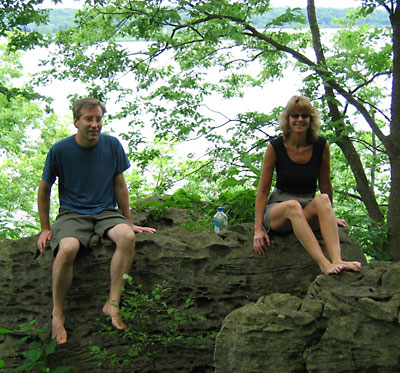 Lyle Lange and Jane Maloney explore the Mississippi River bluffs barefoot in Minnesota's Spring Lake Park Reserve. (Image courtesy of Jim Guttmann and Barefoot Hikers of Minnesota)
Lyle Lange and Jane Maloney explore the Mississippi River bluffs barefoot in Minnesota's Spring Lake Park Reserve. (Image courtesy of Jim Guttmann and Barefoot Hikers of Minnesota)Robillard describes a newfound motivation for running since first shedding his running shoes. “I stumbled upon barefoot running as a potential solution to injuries and fell in love with it,” he says.
Indeed, many barefoot runners say it is an experience like none other.
Hikers
Just as with barefoot running, it is not unusual to be sore after first trying barefoot hiking. “Most likely it’ll be soreness in the leg muscles,” says Roat. “Even if you are a reasonably experienced shod hiker, you’ll be using different muscles as your gait adjusts, so some soreness may result.”
Despite a few minor aches and pains, barefoot hikers speak highly of the barefooting experience, with many becoming enthustiastic advocates.
“Hiking in boots or shoes feels the same with every step,” says Guttmann. “Without shoes, every step feels new and different.”
He describes the first experiences hiking barefoot as akin to coming out of a dark movie theater during the day:
“You step outside and it seems incredibly bright; it takes a little time for your senses to adjust,” he says. “For most people who wear shoes constantly, hiking barefoot for the first time can be overwhelming as you soon realize what you’ve been missing out on.”
Barefoot Resources
Interested in trying the barefoot/minimal hiking and running movement? Start slow, listen to your body, and get qualified training and support. If you have medical problems, questions, or concerns, consult a medical professional.
Also, check out some of the barefoot resources below.
Books
The Barefoot Bookby L. Daniel Howell
The Barefoot Hiker by Richard K. Frazine
The Barefoot Running Book by Jason Robillard
Barefoot Sisters Walking and Barefoot Sisters Southbound by Lucy and Susan Letcher
Born to Run by Christopher McDougall
Clubs
Barefoot Hikers of PA (NJ-DE-MD)
Online
Barefoot Running University
Site of Jason Robillard, Merrell "Barefoot Expert," founding member of the Barefoot Runners Society, and author of The Barefoot Running Book.
Biomechanics of Foot Strikes
Daniel Lieberman's research into different foot strikes in endurance running at the Skeletal Biology Lab at Harvard.
Trailspace Barefoot and Minimal Footwear Reviews
Leg and Foot Exercises
To expedite the transition to the barefoot running style and ward off injuries, try the following lower leg and foot strengthening exercises three days a week. These also will help you strengthen the stabilizer muscles that are vital to the midfoot/forefoot strike pattern:
Single Leg Standing: Stand barefoot on a hard floor on one foot; try not to hold onto anything for balance. Start with 30 seconds and gradually work your way up. Once you get good at it, try closing your eyes and balancing. For the most advanced version, try it on a bosu ball.
Calf Raises: With your feet slightly apart, slowly raise to your toes and slowly lower back down. Start with 20 reps.
ABC's: When you’re sitting at your desk or the dinner table, point your toe and spell out the ABCs. Then switch feet. Try to go through the alphabet two to three times.
Toe Walk: Rise to your toes and tiptoe across a 20-meter hard, flat surface. Start with two lengths and a rest in between.

 by Mackenzie Lobby
by Mackenzie Lobby
